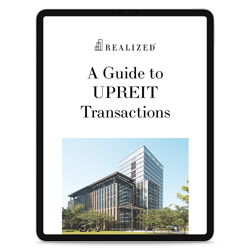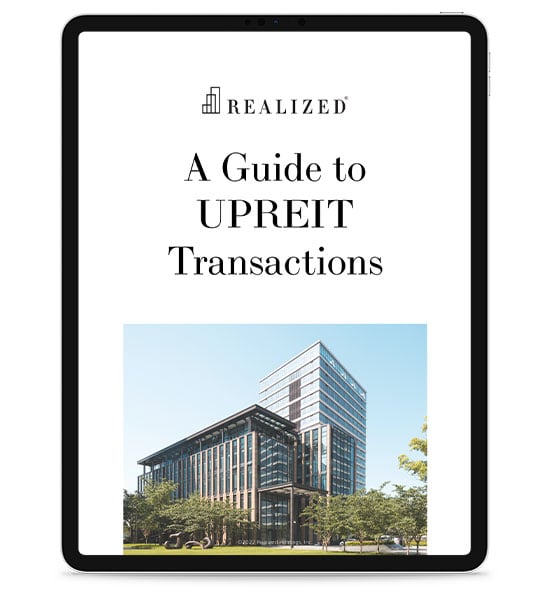
Finding a viable Qualified Opportunity Zone (QOZ) and Qualified Opportunity Fund (QOF) in which to invest your capital gains requires a great deal of thought, consideration, and research. Certainly, the tax deferral benefit is great, but you also need to consider the investment’s underlying real estate project, as well as the fund’s actual framework.
But, exactly how is a QOZ structured? While there are hundreds of qualified opportunity zone projects available for investment, their formats generally fall into two categories: REITs and partnerships. While both have the same QOZ requirements -- at least 90% of assets must be located within qualified opportunity zones and must adhere to the “substantial improvement” obligations -- REITs and partnerships differ when it comes to purpose, direction, and exit strategy.
REITs: Shareholders and Corporations
A real estate investment trust -- or REIT -- is a publicly-traded or non-listed corporate entity that buys, sells, owns, and operates income-producing real estate. A QOZ REIT will be active in Qualified Opportunity Zones.
While REITs target real estate, they are actually structured, and sold, as securities. When you invest in a REIT, you’re buying shares of the corporation that owns real estate, rather than investing directly in the property itself. The underlying real estate income (rather than the sale or any refinancing) helps determine any potential distributions you could receive.
REITs have several potential benefits, one of which is small minimum investment requirements. Another minimal aspect of a REIT is the paperwork; you only need to file a 1099 form to report any profits to the IRS. Furthermore, while REIT dividends are taxed at your ordinary-income rate, that dividend income is also subject to a 20% deduction as Qualified Business Income.
Other possible upsides include liquidity (REIT shares can be more easily bought and sold than conventional real estate equity) and expertise. The value of REITs can be found in the trained professionals who are able to analyze properties, manage them, and forecast markets.
However, if you’re interested in a QOZ REIT investment, you should keep in mind the following limitations:
- Restrictions. REITs are subject to many requirements, as outlined in the IRS Form 1120--REIT. On top of this, REITs must adhere to the many QOZ regulations. The red tape involved with the set-up and operation of this structure can, in turn, hamper growth or the ability to acquire certain assets.
- Arbitrary pricing. While REIT dividends are issued based on asset level cash flows, the REIT’s share price is not. Publicly traded REIT prices are subject to marketplace whims, and might not always reflect the fundamentals and true value of underlying real estate assets.
- Refinancing taxes. If you receive a refinancing distribution from a REIT, that amount is taxable by the amount that exceeds the basis, or specifically, the cost of your investment. The problem, however, is that the REIT can mark that basis to zero, meaning you are on the taxation hook for that entire distribution amount.
Partnerships: Unit Holders and Flexibility
The QOZ partnership structure involves pooling your capital gains with those of other investors, with the total used by the QOF to acquire assets. Your QOZ partnership’s return will come from an asset’s sale (and any carried interest), as opposed to the dividends that you might receive from a REIT.
Furthermore, when you invest in a partnership, you are acquiring direct ownership in the real estate, versus shares of a corporation. Profits are distributed, based on the number of units you own, while the QOF handles transactions, asset and property management, and other ownership tasks.
Partnerships are vastly more flexible than REITs; they are not bound by the same rules or regulations, meaning less rigidity in the amount, or type, of real estate that is owned. Additionally, partnerships have specific, timed exit plans, so you know when to expect a potential profit distribution from the sale of an asset.
QOZ partnerships can also take on non-recourse debt; in other words, loans that don’t require collateral. This, in turn, allows the partnership to establish a specific basis (i.e., the amount of capital investment in a property for tax purposes). Unlike what happens with REIT ownership, refinancing distributions wouldn’t be considered a taxable event, as the distribution would be part of the basis, as opposed to taxable income.
Finally, a partnership doesn’t necessarily have to remain a partnership throughout its QOZ ownership period. It could convert into a publicly-traded REIT without triggering a taxable event for you, the investor.
Though partnerships have more latitude when it comes to QOZ projects, they do come with their own limitations, which are listed below:
- More paperwork. Partnership investments require that you file a K-1 partnership form, for each project, in each state in which the asset is located. If your partnership owns multiple assets in different states, a K-1 form will be required for each of these.
- Higher minimum investments. Many of these funds are in place to attract accredited investors and/or high net-worth individuals; this means minimum investments can start at $25,000. Additionally, the fund might have a commitment and a capital call requirement. This could lead to more uncertainty as to profit timing.
- Illiquidity. Partnership funds are created for a specific investment purpose. As such, the fund’s hold period will be in stone, with one or two extension options. While this provides you with a clear timeline, it means the fund won’t be able to formulate an exit strategy, in the event of a market or economic collapse.
More on Exit Strategies
Whether you’re considering a QOZ REIT or partnership investment, you need to know how, and when, that fund plans to sell the asset, or assets. You also need to determine the type of asset, to help determine ease of exit.
For example, it can be easier to sell single properties -- one-offs -- than mixed-property portfolios. And, if your fund is going the portfolio route, a uniform one, containing one type of real estate asset, can allow for a cleaner, more efficient exit. This is because large entities (such as non-QOZ shopping center REITs, for example), might be willing to pay more for all properties, to create scale and and boost capital deployment efficiencies.
Better Than the Other?
Selecting a partnership or REIT for your investment parameters depends on minimum payment abilities, liquidity requirements, and what’s already in your portfolio. The underlying asset/assets supporting the structure are also important, as is the fund manager’s previous investment experience.
Knowledge of the QOZ structure’s structure helps, as you determine a risk/reward investment strategy. Knowing the purpose of REITs and partnerships -- and how they function -- can help add clarity to your investment decisions, which allows you to determine the appropriate target for your capital gains.
For more information about investing in Qualified Opportunity Zone properties, contact Realized Holdings by logging on to www.realized1031.com, or by calling 877-797-1031.
This material is for general information and educational purposes only. Information is based on data gathered from what we believe are reliable sources. It is not guaranteed as to accuracy, does not purport to be complete and is not intended to be used as a primary basis for investment decisions. It should also not be construed as advice, meeting the particular investment needs of any investor.
There is no guarantee that the investment objectives of any particular program will be achieved.
The actual amount and timing of distributions paid by programs is not guaranteed and may vary. There is no guarantee that investors will receive distributions or a return of their capital. These programs can give no assurance that they will be able to pay or maintain distributions, or that distributions will increase over time.



